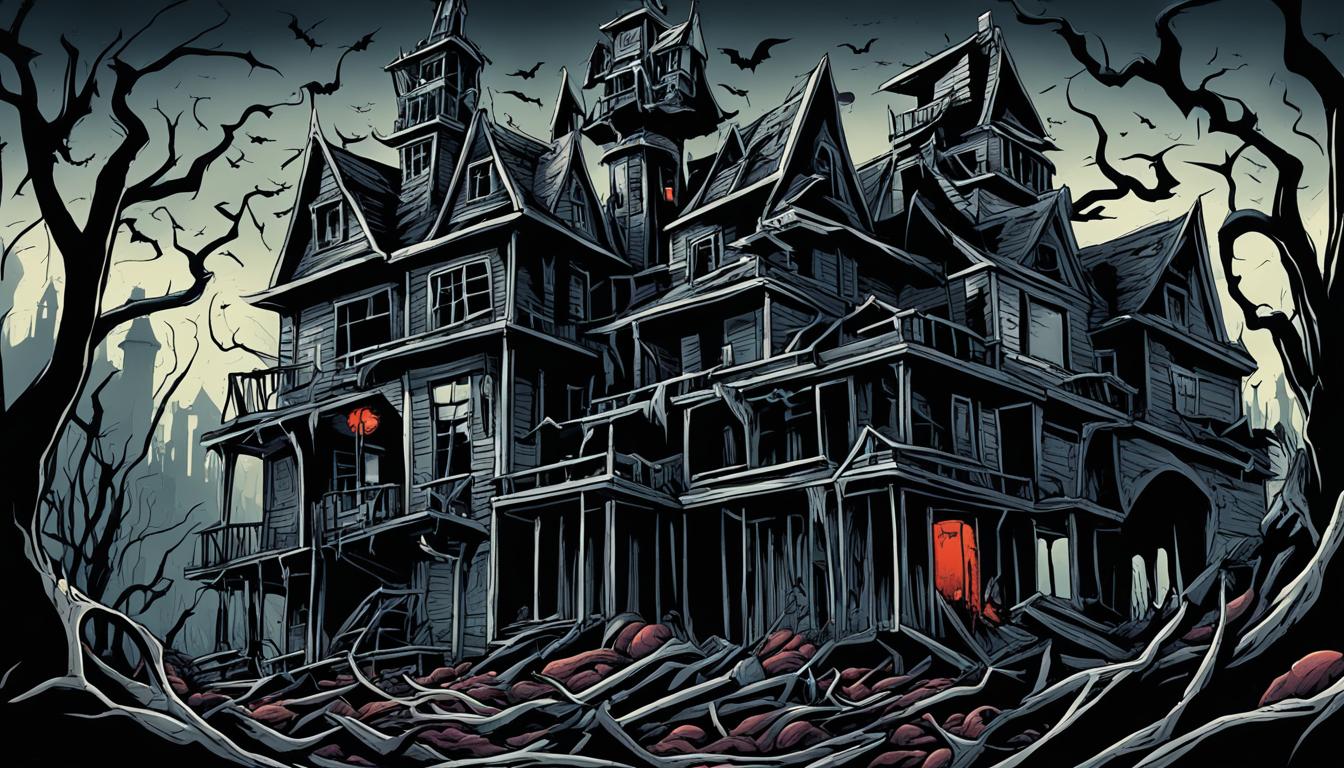In this article, we will dive into one of Stephen King’s most thought-provoking and morally complex novels, “A Necessary Evil.” The book challenges readers to contemplate the nature of right and wrong, good and evil, and the sacrifices we make in the name of justice. Stephen King weaves a masterful tale that takes us on a journey through the dark and twisted human psyche, highlighting the blurred lines between heroism and villainy.
Through this article, we will analyze the novel’s plot, characters, themes, and narrative structure, providing a comprehensive overview of the book’s strengths and weaknesses. We will also explore the wider impact of “A Necessary Evil” on the genre of suspense and the literary world as a whole.
Key Takeaways
- Stephen King’s “A Necessary Evil” challenges readers to consider the moral complexities and ethical dilemmas at the heart of the human experience.
- The novel’s characters are compelling and nuanced, representing a range of perspectives and motivations.
- “A Necessary Evil” explores themes like heroism, villainy, justice, and sacrifice.
- Stephen King’s narrative structure keeps readers engaged through suspense, foreshadowing, and unexpected plot twists.
- The book’s impact on the suspense genre and literary landscape has been significant, influencing other authors and contributing to the evolution of the genre.
The Premise of “A Necessary Evil”
Stephen King’s novel “A Necessary Evil” is a gripping tale of suspense that hooks readers from the very first page. Set in a small town in Maine, the story revolves around the murder of a young girl and the subsequent investigation led by Detective Ralph Anderson.
What starts as a seemingly straightforward case quickly spirals into a complex web of moral complexities and ethical dilemmas. Compelled by his own sense of justice, Anderson becomes obsessed with bringing the perpetrator to justice, even if it means breaking the law himself.
As the plot unfolds, King introduces a cast of intriguing characters, each with their own secrets and motivations. From the victim’s family members to the local residents with something to hide, the novel’s ensemble cast adds depth and nuance to the story.
King’s masterful use of pacing and foreshadowing keeps readers on the edge of their seats, drawing them deeper into the moral gray areas of the plot. With its twists and turns, “A Necessary Evil” is not just a thrilling read, but also a poignant commentary on the human condition.
Character Analysis in “A Necessary Evil”
Stephen King is renowned for his ability to create lifelike characters that leave a lasting impact on readers. “A Necessary Evil” is no exception, featuring a diverse cast of individuals with unique personalities and motivations.
At the center of the story is Kevin Delavan, a small-town businessman who finds himself caught in a web of deceit and corruption. As the protagonist, Delavan must navigate a complex world where nothing is as it seems, all while grappling with his own moral compass.
Beyond Delavan, there is a host of supporting characters that add depth and richness to the narrative, such as the cunning lawyer Jane Hendricks and the dangerous gangster Frank Black. Each character has their own motivations and secrets, driving the plot forward and building tension with every page turn.
Despite their flaws and imperfections, Stephen King’s characters feel real and relatable, eliciting empathy and emotional investment from readers. Their interactions and conflicts form the backbone of “A Necessary Evil,” making it a truly compelling read.
“Stephen King’s ability to create realistic and complex characters is on full display in ‘A Necessary Evil.’ From the protagonist to the supporting cast, each individual leaves a lasting impression and fuels the story’s tension and conflict.”
The Setting of “A Necessary Evil”
The setting plays a crucial role in “A Necessary Evil” and Stephen King masterfully brings it to life through his vivid descriptions and attention to detail. The novel is set in a small town in Maine, adding to the book’s eerie and unsettling atmosphere. The town is portrayed as isolated, with a sense of foreboding and danger lurking around every corner.
King’s use of descriptive language draws the reader in, allowing them to picture the town and its surroundings in their minds. The snow-covered streets, the fading buildings, and the desolate countryside all contribute to the haunting atmosphere that permeates the story.
The setting also serves as a way to reinforce the moral complexities and ethical dilemmas that the characters face. The isolated town and its harsh environment increase the pressure on the characters, leading to difficult decisions and actions that have far-reaching consequences.
The setting in “A Necessary Evil” is not just a backdrop, but a vital element in the story’s overall impact. By crafting a rich and detailed environment, Stephen King elevates the reading experience, immersing the reader into the character’s world. As the story progresses, the setting becomes increasingly crucial, adding to the tension and pushing the narrative forward towards its climactic end.
Themes Explored in “A Necessary Evil”

Stephen King’s “A Necessary Evil” explores various themes that reflect the complexities of human nature. Through his characters, King delves into the moral dilemmas and ethical conundrums that arise from our choices.
The novel challenges readers to question their own beliefs and values, as they contemplate the consequences of their actions. The themes of morality, justice, and redemption are deeply ingrained in the narrative, reinforcing the idea that no choice is ever truly black and white.
King’s exploration of the human psyche and the consequences of our decisions makes “A Necessary Evil” an incredibly thought-provoking read. The author’s ability to create multi-dimensional characters adds to the complexity of the novel and makes it all the more engaging.
The Narrative Structure of “A Necessary Evil”
In “A Necessary Evil,” Stephen King showcases his mastery of narrative structure, using suspense, foreshadowing, and plot twists to keep readers engaged throughout the story. The novel is divided into three distinct parts, each building on the previous one to create a gripping, page-turning experience.
One of the most significant narrative devices used by King in this book is the use of multiple narrators, each providing a unique perspective on the events unfolding. This technique adds layers of complexity to the story, as readers are forced to piece together the larger narrative from different, sometimes conflicting, viewpoints.
King also employs extensive flashbacks, allowing readers to gain insight into the characters’ motivations and past experiences. These flashbacks are carefully placed throughout the narrative, creating a sense of continuity and adding depth to the overall story.
Another vital component of the narrative structure of “A Necessary Evil” is the use of foreshadowing. King drops subtle hints throughout the story, building tension and anticipation for the inevitable conclusion. The plot twists that King incorporates create a sense of unpredictability, preventing readers from guessing the outcome and keeping them invested in the story from start to finish.
Overall, the narrative structure of “A Necessary Evil” is a testament to Stephen King’s unparalleled storytelling ability. By employing a variety of techniques, he creates a layered, complex narrative that captivates readers and leaves a lasting impression.
The Use of Suspense
King’s use of suspense is paramount in this book, creating tension and driving the narrative forward. By maintaining a sense of uncertainty about what will happen next, King keeps readers engaged and on the edge of their seats throughout the story.
The Role of Foreshadowing
Foreshadowing is also a crucial element in the narrative structure of “A Necessary Evil,” creating anticipation for the inevitable conclusion. As readers progress through the story, they begin to pick up on subtle clues about what might happen, building a sense of excitement and intrigue.
“Stephen King’s use of narrative structure in ‘A Necessary Evil’ is nothing short of masterful. He keeps readers engaged from start to finish, using a variety of techniques to create a gripping, complex narrative that leaves a lasting impression.”
Critique of “A Necessary Evil”
Now that we have examined the various elements of “A Necessary Evil,” it’s time to offer a critique of the novel. Stephen King is known for his gripping storytelling and vivid imagery, and this book is no exception. However, there are also some areas where the novel falls short.
One of the strengths of “A Necessary Evil” is its ability to tackle complex moral issues and present them in a relatable and engaging way. The characters are well-developed and the plot is full of unexpected twists and turns. However, some readers have criticized the book for its slow pacing and lengthy descriptions.
Despite these criticisms, “A Necessary Evil” remains a standout novel in the suspense genre and a testament to Stephen King’s skill as a writer. It offers a thought-provoking look at the morality of our decisions and the consequences of our actions.
“‘A Necessary Evil’ is a masterful work of suspense that showcases Stephen King’s talents as a writer. However, the slow pacing and lengthy descriptions may not be for everyone. Overall, it is a must-read for fans of the genre.”
Impact of “A Necessary Evil” on the Genre
Stephen King’s “A Necessary Evil” has had a significant impact on the genre of suspense and the broader literary landscape. The novel explores moral complexities and ethical dilemmas in a way that resonates with readers and continues to inspire new authors.
King’s masterful storytelling has influenced numerous other suspense writers to delve deeper into the psychological and emotional aspects of their characters and plots. By doing so, they are able to engage readers on a deeper level and create truly memorable stories.
Furthermore, “A Necessary Evil” has contributed to the evolution of the suspense genre by introducing a fresh perspective and challenging traditional storytelling methods. The novel’s impact can be felt in countless other works of fiction, and its influence shows no signs of abating.
Conclusion
Stephen King’s “A Necessary Evil” is a masterful work of suspense that highlights the moral complexities that drive human behavior. King’s ability to craft realistic and compelling characters, vividly describe settings and employ engaging narrative structures is unparalleled.
Readers are drawn into the story from the start, captivated by the ethical dilemmas and challenges presented to the characters. The thought-provoking themes examined throughout the novel leave a lasting impact on readers, exploring the depths of human nature and consequences of our actions.
The impact of “A Necessary Evil” on the literary landscape is impressive, with King’s work influencing and inspiring other authors in the suspense genre. Through its critical and commercial success, it has cemented its place in literary history, regarded as a masterpiece of suspense.
In conclusion, “A Necessary Evil” is a must-read for anyone seeking a well-crafted, thought-provoking novel that will keep them engaged from start to finish. Stephen King’s unmatched storytelling ability and exploration of ethical complexities make this novel a true work of art.



